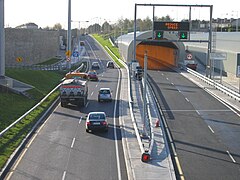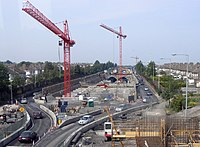Dublin Port Tunnel
| Dublin Tunnel | |
| County Dublin | |
|---|---|
 Dublin Tunnel, southbound entrance, December 2006 | |
| Location | |
| Carrying: | M50 motorway |
| Location | |
| Location: | 53°21’40"N, 6°14’3"W |
| Structure | |
| Length: | 2.8 miles |
| History | |
| Opened 2006 | |
| Information | |
| Owned by: | Transport Infrastructure Ireland |
| Website: | www.dublintunnel.ie |
The Dublin Tunnel, originally and still commonly known as the Port Tunnel, is a road traffic tunnel in Dublin, County Dublin, that forms part of the M50 motorway.
The twin tunnels form a two-lane dual carriageway connecting Dublin Port, which lies to the east of central Dublin, and the M50 motorway at junction 2, close to Dublin Airport. The tunnels are 2.8 miles in length and total project length of 3.5 miles. It had final cost of approximately €752 million.

The tunnel was officially opened on 20 December 2006; it was initially only open to Heavy Goods Vehicles.[1] It was opened to all traffic on 28 January 2007.[2]
Purpose
Traffic congestion in central Dublin became severe at the end of the 20th century, with thousands of heavy goods vehicles travelling to and from Dublin port via the city centre. The tunnel relieves surface road congestion in Dublin city centre by diverting heavy goods vehicles from Dublin Port directly onto the motorway network. This has positive knock-on effects for bus users, pedestrians and cyclists travelling along the city quays, including better air quality and safer travel.
To discourage commuters from using the tunnel, vehicles other than HGVs are heavily tolled at peak times. HGVs travelling north and west benefit from the expected six-minute journey time through the tunnel. A tunnel was chosen as it was decided that a surface relief road was not feasible.
Dublin Bus routes 142, 33x and 41x use the tunnel to get to the port area of the city from the northern suburbs.
Longer distance buses from Belfast, Londonderry and Letterkenny also use the route.
Port tunnel project
The tunnel was first suggested in the 1990s after a number of transportation and engineering studies and was included in the Dublin City Development Plan 1999 – 2005. The project was approved following a public inquiry in 1999.
The tunnel formed part of the National Development Plan and funds were provided under the plan to the National Roads Authority by the Department of Transport. The contract was managed by Dublin City Council.
The tender price for construction of the tunnel was €457 million. The final project cost was brought to €752 million by land acquisition, design, insurance, legal and other services, plus supervision by Brown & Root.
Construction commenced in June 2001 and the tunnel was originally due to open in 2005 after an elapsed time of 43 months. It eventually opened in December 2006, giving an elapsed time of 66 months.
One reason for the project extension was to allay residents' noise concerns. Under some areas such as Griffith Avenue and the Cloisters, boring was restricted to 16 hours a day. Under Annadale Crescent it was reduced to 13 hours.
Tunnel specifications
- Length: 2.8 miles – total project 3.5 miles
- Bores: 2
- Bore width: 38 feet 7.82 inches
- Lane width (two per bore): 11 ft 11.70 inches
- Shoulder width (two per bore): 3 ft 3.37 inches
- Bore height: 16 ft 0.91 inches
- Operating height: 15 ft 3.07 inches
- Lowest point: −98 ft 5.10 inches at Marino
It is the fourth longest urban motorway tunnel in Europe after Madrid M-30, Blanka tunnel complex in Prague and Södra länken in Stockholm, Sweden. When non-urban road tunnels are included, the Dublin Port Tunnel is shorter than some other European tunnels, such as the Lærdal Tunnel (Lærdalstunnelen) in Norway (15.2 miles), the Gotthard Road Tunnel in Switzerland (10.6 miles), the Mont Blanc Tunnel between France and Italy (7.2 miles) and the Western Scheldt Tunnel (Westerscheldetunnel) in The Netherlands (4.1 miles).
Tunnel design
The tunnel was built in five sections including a pipe-jacked section under the Dublin-Belfast railway line.
The "cut and cover" sections at both ends featured excavations as deep as 39 feet into which horseshoe-shaped sections of reinforced concrete were cast in-situ and backfilled. The southern section, at Fairview, is 500 yards long while the northern cut and cover channel from Whitehall Church to Shantalla extends over 1,500 yards.
Both bored sections were initiated from a shaft 108 feet deep and 187 feet in diameter created at Collins Avenue by Mowlem in a joint venture with Intrafor of France. From here, the tunnel boring machines were sent north through open clay and south through hard limestone. As is traditional, both machines were named after women – Meghan for 710 yards of open clay and Grainne for 2,840 yards of limestone.
The bores were completed with breakthrough into the reception shaft on 18 November 2003 and 18 August 2004 for clay and rock, respectively. Much of the bored sections are 70 feet to 75 feet below the surface, with the lowest point at Marino, towards the southern end, a point that also hosts the tunnel's drainage sump.
A particular challenge was faced near the southern portals where the tunnel passes under the Dublin to Belfast railway, a line that also carries suburban and commuter services. The railway was constructed on an elevated embankment made up of soft materials resting on alluvial deposits of sand and silt. Because the railway had to remain operational at all times, the cut and cover approach could not be used. Nishimatsu constructed a pipe-jacked supporting structure for the railway 11 feet below the surface. The tunnel was then constructed in the supported space using horse-shoe sections and backfilled.
A new entrance and exit for the Dublin port was constructed including a new bridge over the Tolka river that connects to the toll plaza and southern portals. A new junction and underpass facilitates traffic from the East Wall Road towards the tunnel.
Citybound traffic approaching the tunnel on the M50 (formerly the M1 at this point) can utilise two tunnel-bound lanes or two surface lanes that continue as the N1 toward Whitehall. Traffic emerging at the southern portal approaches the toll plaza outside the port.
Tolling
The tunnel is tolled, with funds collected remitted to the Department of Transport. To facilitate the ban on 5-axled HGVs in Greater Dublin, there are no tolls for vehicles in excess of 3,500 kg MLW, or for vehicles capable of carrying 25 passengers or more.
Tunnel runs
The Dublin Port Tunnel has been closed to traffic and used for 10k races on three occasions since it opened. The most recent event was held on 26 March 2017, when over 2,400 runners participated in the "Underground Run", with proceeds going to the homeless charity Focus Ireland.[3][4]
Outside links
| ("Wikimedia Commons" has material about Dublin Port Tunnel) |
References
- ↑ Port Tunnel to open on 20 December, RTÉ News
Port tunnel opens after last-minute delay, RTÉ News - ↑ Port Tunnel opens to all users, RTÉ News
- ↑ D'Arcy, Ciarán (26 March 2017). "Dublin Port Tunnel closes for Focus Ireland charity run". The Irish Times. http://www.irishtimes.com/news/ireland/irish-news/dublin-port-tunnel-closes-for-focus-ireland-charity-run-1.3025124. Retrieved 27 April 2017.
- ↑ "Underground Run: Dublin Tunnel". https://www.focusireland.ie/get-involved/dublin-tunnel-run/. Retrieved 27 April 2017.
